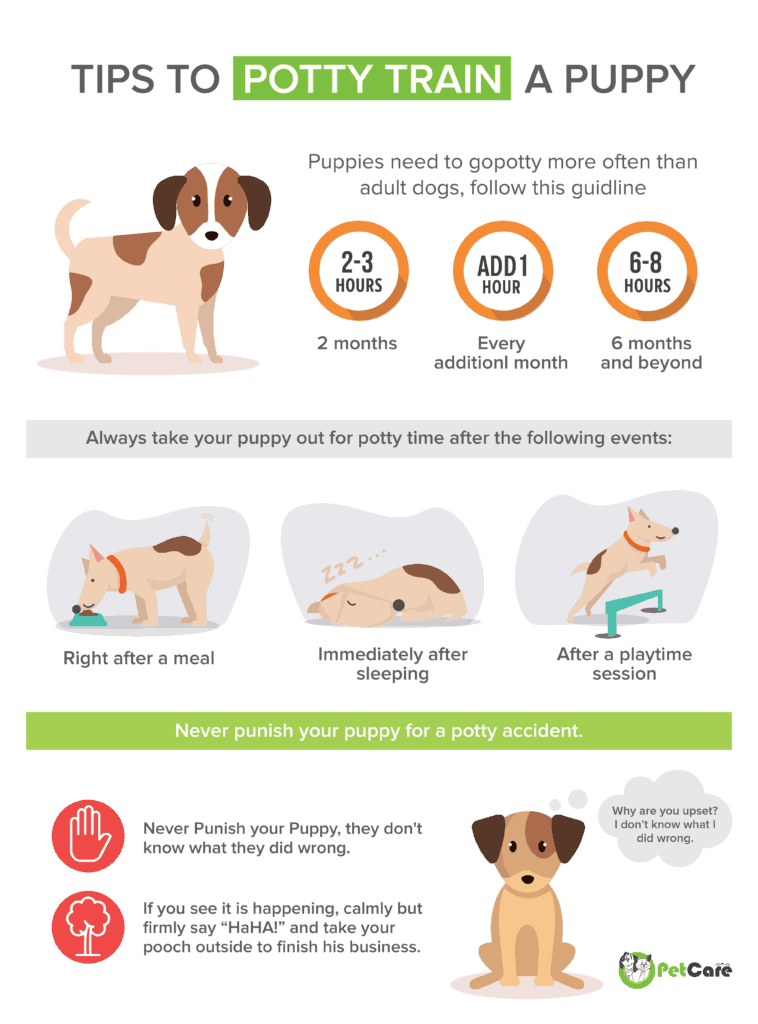Learning
How to Potty Train a Puppy? The Best And The Fastest Way.
Published
4 months agoon
By
Dan Harry
Are you struggling to potty train your new puppy and wondering how to get it right fast? You’re not alone! For new dog owners, potty training can often seem like a daunting task. After all, you want to avoid endless cleaning, accidents in the house, and most importantly, create a healthy routine for your furry friend. But what if we told you there’s a way to effectively potty train a puppy in a way that’s both quick and stress-free?
In this blog, we’ll guide you through tried-and-tested strategies for successfully potty training your puppy. By understanding their needs and implementing a few smart techniques, you can make the process smoother and help your puppy learn faster. Let’s dive in and explore the best and fastest ways to potty train your new furry companion!
1. Understanding Potty Training Basics

Potty training is a critical step in raising a well-behaved and happy puppy. But before diving into the specifics, let’s explore why it’s so important and how to set your training up for success.
1.1: The Importance of Early Potty Training
Why is early potty training so crucial? For starters, it helps puppies establish positive bathroom habits right from the beginning. This not only keeps your home clean but also builds your puppy’s confidence. By creating a consistent routine, you’ll lay a strong foundation for a well-trained dog in the future.
1.2: Choosing the Right Time and Place for Training
Have you wondered why some puppies learn faster than others? Often, it comes down to timing and location. Puppies, like humans, are creatures of habit. They thrive on consistency. Choose a designated potty area, preferably a quiet spot in your yard, and stick to it. Take your puppy to the same place each time, using a gentle tone and commands. This reinforces the behavior you want to see.
1.3: Common Potty Training Challenges
Potty training a puppy can be tricky, and knowing what challenges to expect is half the battle. Here are a few common hurdles and how to tackle them:
- Frequent Accidents: This is completely normal at first. Be patient and focus on rewarding good behavior instead of punishing mistakes.
- Nighttime Potty Breaks: Puppies have small bladders. Ensure you’re prepared for late-night trips to the designated spot.
- Inconsistent Schedule: Lack of consistency can confuse your puppy. Stick to a schedule for feeding, playing, and potty times.
Understanding these basics will help you lay the groundwork for the next steps in successfully potty training your puppy. With the right approach, you’ll soon see noticeable progress!
2. Preparing for Potty Training

Potty training a puppy takes a bit of planning and preparation. By organizing the essentials and setting up a proper environment, you can streamline the entire process. Let’s dive into what you need to get started on the right foot.
2.1: Essential Supplies You’ll Need
Before you begin, it’s essential to gather the right supplies to help you and your puppy succeed. Here’s a list of must-haves:
- Puppy Pads: These are especially helpful for indoor training sessions or apartment living.
- Crate: A crate provides a safe and comfortable space for your puppy, which also helps with potty training.
- Leash and Collar: Essential for taking your puppy to the designated potty area consistently.
- Treats: Always have a supply of small, soft treats to reward successful potty breaks.
2.2: Creating a Designated Potty Area
Have you thought about where you want your puppy to do their business? Choosing a specific potty area is key. This spot should be easy to access and free from distractions. When you take your puppy there regularly, they’ll start associating that location with the task at hand. Over time, this consistency will significantly reduce accidents around the house.
2.3: Setting a Consistent Schedule
Consistency is the cornerstone of successful potty training. Puppies learn best when their routine is predictable. Here’s a basic schedule to follow:
- Morning: Take your puppy out first thing after waking up.
- After Meals: Allow some playtime, then take your puppy out for a potty break.
- After Naps: Puppies need to relieve themselves after sleeping, even if it’s a quick nap.
- Before Bedtime: A final trip to the designated potty area will reduce overnight accidents.
Creating a consistent schedule not only teaches your puppy where and when to go, but it also helps establish a routine that they can rely on. Remember, every puppy is different, so be prepared to make minor adjustments based on your puppy’s progress!
Why Are Dogs, Cats, and Sharks Trending? Exploring the Internet’s Favorite Animals
3. Step-by-Step Potty Training Techniques

When it comes to potty training, having a step-by-step approach is crucial. But where should you start, and what methods work best? Let’s explore some of the most effective techniques for successfully training your puppy to avoid accidents in the house.
3.1: Crate Training: How to Use It Effectively
Crate training is an essential method in the potty training process. But how does it help? Dogs naturally avoid soiling their sleeping area, so using a crate as a designated safe space can encourage your puppy to hold their bladder. Start by introducing the crate as a positive, cozy place for your puppy. Remember, it’s not meant to be a punishment but a training tool! Gradually increase the time your puppy spends in the crate and take them to the potty area immediately after letting them out.
3.2: Positive Reinforcement: Treats and Praise
Ever wondered why some dogs respond so well to training? It often comes down to positive reinforcement. When you potty train a puppy, using treats and verbal praise immediately after they successfully relieve themselves is key. Make sure the praise is enthusiastic and consistent your puppy will quickly associate good behavior with rewards.
3.3: Timing and Frequency: When and How Often to Take Your Puppy
Timing is everything when potty training a puppy. A good rule of thumb is to take your puppy to the designated potty area every 1-2 hours. Additionally, take them out:
- First thing in the morning
- After meals or drinking water
- After naps or playtime
- Before bedtime
This routine helps your puppy build a reliable schedule and reduces the likelihood of accidents.
3.4: Correcting Accidents Without Punishment
Accidents will happen it’s a natural part of the process. But what’s crucial is how you respond. Instead of punishing your puppy, which can create fear and confusion, focus on redirecting their behavior. If you catch them in the act, calmly interrupt them and guide them to the designated potty area. Praise them if they finish there to reinforce the right behavior.
By following these techniques, you’ll establish a clear and structured process for potty training your puppy. Remember, consistency and patience are the keys to a successfully trained dog!
4. Establishing a Routine

Creating a consistent routine is essential for potty training a puppy. Just like people, puppies thrive on routines they provide structure and predictability, making the entire process easier for both you and your new furry friend.
4.1: Morning, Afternoon, and Nighttime Training Routines
Have you ever wondered why puppies seem to have a lot of accidents early on? Often, it’s because they don’t have a clear routine. To avoid this, establish a training schedule that includes set times for potty breaks:
- Morning: Take your puppy out as soon as they wake up.
- Afternoon: After meals and during active playtime.
- Nighttime: A final potty break right before bed to prevent overnight accidents.
4.2: Feeding and Potty Timing Correlation
Did you know that feeding schedules directly impact your puppy’s potty routine? By feeding your puppy at the same times every day, you can anticipate when they’ll need to go out. Generally, puppies need a potty break 15 to 20 minutes after eating, so plan accordingly.
4.3: How to Adjust Routines Based on Your Puppy’s Progress
Not all puppies learn at the same pace, and that’s perfectly normal. It’s important to adjust the potty training routine based on your puppy’s development. If they’re having fewer accidents, gradually extend the time between potty breaks. On the other hand, if you notice increased accidents, consider shortening the intervals until they regain control.
Building and maintaining a consistent routine helps your puppy learn what to expect and when, leading to fewer accidents and a smoother training process.
5. Troubleshooting Common Issues

Even with the best plans, potty training doesn’t always go smoothly. Puppies can be unpredictable, and you might face a few challenges along the way. Let’s explore some common issues and how to address them effectively.
5.1: Dealing with Accidents: What to Do
It’s frustrating when accidents happen, but it’s crucial to stay calm and composed. If you catch your puppy in the act, use a firm but gentle “no” to interrupt them and then guide them to the potty area. Clean up accidents thoroughly to remove lingering scents, as puppies may return to spots with residual odors.
5.2: Signs Your Puppy Isn’t Ready for Outdoor Potty
Are you struggling to get your puppy to go potty outside? It could be a sign that they’re not yet comfortable with the outdoors. Look for signs like hesitation, sniffing around nervously, or trying to retreat indoors. If this happens, take it slow. Spend time with your puppy in the designated potty area without pressuring them, and use treats to create a positive association.
5.3: Addressing Nighttime Potty Breaks
Nighttime accidents are common for young puppies due to their small bladders. To address this, consider setting an alarm to take them out at least once during the night. As your puppy grows, you can gradually phase out nighttime breaks as they develop better bladder control.
Troubleshooting these issues with patience and consistency will help your puppy feel more secure and confident during the training process.
6. Tips for Faster and Stress-Free Potty Training

Potty training a puppy can feel overwhelming, but there are strategies you can use to speed up the process and make it less stressful for both of you. Let’s explore some practical tips to help you along the way.
6.1: Using Commands to Train Faster
Have you considered using commands to make potty training more efficient? Introducing a simple command like “Go potty” every time you take your puppy to their designated spot helps them associate the words with the action. Over time, this will help your puppy understand what’s expected of them and speed up the process.
6.2: Avoiding Negative Reactions: What to Never Do
Negative reactions, such as yelling or punishing your puppy for accidents, can set back their training. Puppies don’t understand punishment the way humans do, and harsh reactions may only cause confusion and fear. Instead, focus on redirecting and rewarding good behavior to create a positive learning environment.
6.3: Making Potty Training Fun and Rewarding
Believe it or not, potty training can be a fun bonding experience. Use positive reinforcement, like treats and praise, and try to turn training into a game. Celebrate small wins, and remember to be patient with your puppy. They’re learning something completely new, and your encouragement will keep them motivated.
By using these strategies, you’ll not only speed up the potty training process but also create a stronger bond with your puppy based on trust and positive reinforcement.
What is the 10 minute rule for potty training?
The 10-minute rule suggests taking your puppy to their designated potty area every 10 minutes during active times, like after playtime, meals, or naps. This helps reinforce good habits and reduce accidents.
Can an 8-week-old puppy be potty trained?
Yes, an 8-week-old puppy can start potty training. While they won’t be fully trained yet, starting early establishes routines and helps them learn where and when to go.
What is the 3-day potty method?
The 3-day potty method involves intense, consistent supervision and frequent potty breaks over a short period (typically three days). The idea is to provide constant guidance to create a rapid learning curve for the puppy.
How to begin potty training?
To start potty training, choose a designated potty area, create a consistent schedule, and use positive reinforcement like treats and praise. Stay patient and focus on rewarding good behavior rather than punishing accidents.
Conclusion
Potty training a puppy might seem challenging at first, but with the right techniques and a little patience, it’s a goal you can achieve sooner than you think. Remember, every puppy is unique and may require a slightly different approach. So, as you embark on this journey, ask yourself: Are you ready to stay consistent and celebrate small wins along the way? The key to success is creating a routine, reinforcing positive behavior, and being patient during setbacks.
Think of potty training not just as a task, but as an opportunity to build trust and a stronger bond with your puppy. The consistency you establish now will set the stage for a well-behaved dog in the future. And don’t forget mistakes are just part of the learning process. So, if accidents happen, view them as a chance to adjust and fine-tune your training.
By following these guidelines, you’ll not only have a housebroken puppy, but you’ll also develop the confidence to tackle future training challenges. After all, every step you take today lays the groundwork for a happy, healthy, and obedient dog tomorrow. Good luck on your potty training journey! Are you ready to get started?
FAQs
-
How to housebreak a puppy?
Housebreaking a puppy involves setting up a consistent schedule for feeding and potty breaks, using a designated potty area, and rewarding them with treats and praise when they go in the right spot.
-
How to house train your dog?
House training a dog is similar to potty training a puppy. Create a routine, designate a potty area, and use positive reinforcement. Consistency and patience are key to successful house training.
-
Best way to toilet train a puppy?
The best way to toilet train a puppy is to set up a regular schedule, use positive reinforcement, and keep accidents to a minimum by supervising your puppy closely.
-
House training a puppy in 5 days
While complete training in 5 days is ambitious, you can make significant progress by consistently taking your puppy to the designated potty area every 1-2 hours, reinforcing success with treats, and closely monitoring for signs they need to go.
-
At what age should a puppy be potty trained?
Most puppies start potty training at around 8 weeks of age, and by 4 to 6 months, they typically have better control and understanding of the routine.
-
How long does it take to toilet train a puppy?
On average, it takes about 4 to 6 months to fully toilet train a puppy. However, this varies based on the breed, age, and consistency of training.
-
Five Million People Watched Me Empty My Dishwasher
It sounds surreal, doesn’t it? The thought of five million people tuning in to watch someone perform the mundane task of emptying a dishwasher. Yet, that’s exactly what happened to me. What began as a random upload on social media turned into a viral phenomenon, leaving me both amused and fascinated by the power of…
-
Instagram Restricts Search Results for ‘Democrats’
Recent reports have surfaced highlighting Instagram’s restriction of search results for the term “Democrats,” raising concerns over content moderation and platform bias. Users searching for this political term encountered limited results or were redirected to general information pages, sparking debate over the social media giant’s decision-making process regarding sensitive political content. This development has prompted…
-
Canada Sidesteps Trump’s Tariffs – At Least for Now
In a move that has temporarily shielded Canada’s economy, the country has managed to avoid being impacted by the latest round of tariffs announced by former U.S. President Donald Trump. While many of America’s traditional trading partners brace for the economic blowback of these measures, Canada has, for now, escaped the fray. However, the reprieve…
You may like
Learning
The Future of Mankind by Bertrand Russell: A Critical Analysis
Published
2 months agoon
December 28, 2024By
Dan Harry
What does the future hold for humanity? As we navigate an era of rapid technological advancement, global challenges, and shifting moral landscapes, this question feels more pressing than ever. Decades ago, renowned philosopher Bertrand Russell sought to answer it in his thought-provoking essay, The Future of Mankind. His reflections resonate even today, offering profound insights into humanity’s potential paths both perilous and promising.
In this blog, we’ll critically analyze Russell’s vision, unraveling his core arguments and exploring their relevance in today’s world. What lessons can we draw from his ideas about cooperation, rationality, and ethical responsibility? How can his philosophy guide us in shaping a future that safeguards both progress and survival?
Let’s delve into the timeless wisdom of Bertrand Russell and examine what it means for the future of mankind.
I. Understanding Bertrand Russell’s Vision
Bertrand Russell was more than just a philosopher he was a visionary thinker who dared to tackle the big questions about humanity’s destiny. In his essay The Future of Mankind, Russell offers a roadmap to understanding our collective potential and the risks that threaten it. But why is his vision still so relevant today?
Let’s break it down:
1. Russell’s Philosophical Approach
At his core, Russell believed in the power of rationality and logic. He argued that humanity’s future depends on our ability to think critically and act with foresight. This emphasis on intellectual clarity serves as the foundation of his essay.
2. The Historical Context of “The Future of Mankind”
Written during the mid-20th century, a time marked by global conflicts and the dawn of nuclear weaponry, Russell’s essay reflects the urgency of his era. Yet, the themes he addresses war, division, and the role of science are timeless, echoing the challenges we face in the 21st century.
3. Key Themes Explored in the Essay
Russell dives into profound themes, such as:
- The interplay between human progress and ethical responsibility.
- The growing influence of science and technology on society.
- The threats posed by unchecked ambition and geopolitical rivalries.
These ideas lay the groundwork for understanding how Russell envisioned a balanced and sustainable future.
So, why does this matter today? Because Russell’s vision offers a mirror to our current challenges. As we face climate change, technological upheavals, and global tensions, his insights remind us of the enduring importance of collaboration, rational thinking, and ethical leadership.
Stay with us as we explore how these ideas unfold throughout The Future of Mankind.
II. The Core Arguments in “The Future of Mankind”
What exactly does Bertrand Russell propose about humanity’s future? His essay unpacks a complex web of ideas, balancing optimism with caution. At the heart of his arguments lies a compelling exploration of progress, science, and the ever-present dangers threatening mankind’s survival. Let’s take a closer look.
1. Russell’s Perspective on Human Progress
Russell believed that human progress isn’t inevitable it’s a choice. He emphasized that while advancements in technology and science have propelled humanity forward, they’ve also introduced new risks. Are we prepared to wield these advancements wisely?
2. The Role of Science and Technology
For Russell, science was both a blessing and a potential curse. On the one hand, it enables incredible leaps in medicine, communication, and knowledge. On the other, it powers destructive forces, such as nuclear weapons. He urged society to balance scientific innovation with ethical responsibility.
3. Threats to Survival
Russell highlighted three key threats:
- War: The constant risk of global conflict fueled by nationalism and power struggles.
- Division: The inability of nations to cooperate, leading to fragmented efforts to solve shared problems.
- Short-sightedness: A lack of long-term thinking, especially regarding the consequences of technological and political decisions.
These core arguments form the backbone of Russell’s essay, forcing readers to confront the delicate interplay between opportunity and risk.
What’s remarkable is how these warnings still resonate today. Are we doing enough to address these dangers? Or are we repeating the same mistakes?
III. Russell’s Solutions for Humanity’s Future
If the future seems precarious, does Bertrand Russell offer a way out? Thankfully, yes. His essay is as much a guidebook for action as it is a warning. Russell outlines practical solutions that focus on unity, rationality, and moral responsibility.
1. Global Cooperation as a Priority
Russell argued that humanity’s survival depends on nations working together. He envisioned a world where collective efforts rather than competition drive progress. Imagine what we could achieve if global powers united to tackle issues like climate change and inequality.
2. Rational Thinking in Decision-Making
Irrational fears and emotional reactions often lead to poor choices. Russell stressed the importance of logical thinking in political and social spheres. He believed that humanity’s greatest strength lies in its ability to reason and learn from past mistakes.
3. Ethical Responsibility
Russell didn’t shy away from discussing morality. He believed that progress without ethics is dangerous. By fostering a sense of shared responsibility, we can create a future that benefits all, not just a privileged few.
His solutions aren’t just philosophical musings they’re calls to action. The question remains: Are we willing to listen?
IV. Modern Relevance of Russell’s Ideas
Is Bertrand Russell’s vision still relevant today? Absolutely. The themes he explored in The Future of Mankind from cooperation to ethical responsibility are more urgent than ever in our rapidly changing world.
1. Resonance in the 21st Century
Russell’s warnings about war and division ring true in an age of geopolitical tension. Whether it’s international conflicts or political polarization, his insights remind us of the dangers of disunity.
2. Lessons for Addressing Today’s Challenges
Russell’s emphasis on rationality and ethics can guide us as we confront:
- Climate change and environmental degradation.
- The ethical dilemmas posed by artificial intelligence and automation.
- Growing disparities in wealth and opportunity.
3. Applying Philosophy to Modern Issues
Russell’s philosophy offers more than theoretical insights it’s a toolkit for navigating contemporary challenges. By embracing his principles, we can foster a more equitable, peaceful, and sustainable future.
Are we ready to take these lessons to heart? Or will history repeat itself?
V. Critiquing Russell’s Vision
While Russell’s ideas are profound, no vision is without its flaws. A critical analysis reveals both the strengths and limitations of his arguments, offering a balanced perspective on his work.
1. Strengths of Russell’s Insights
- Timeless relevance: His warnings about war, division, and short-sightedness remain strikingly applicable.
- Logical clarity: Russell’s arguments are structured and easy to follow, making them accessible to a wide audience.
2. Limitations of His Vision
- Overlooked cultural complexities: Russell’s solutions sometimes assume a level of global cooperation that may not align with cultural and political realities.
- Idealism vs. pragmatism: His ideas, while inspiring, occasionally lack concrete steps for implementation.
3. Balancing the Critique
Despite these limitations, Russell’s work remains invaluable. His ability to spark dialogue and inspire action outweighs any perceived shortcomings.
By understanding both the strengths and gaps in his vision, we can adapt his ideas to better suit modern realities.
VI. Implications of Russell’s Thoughts for Future Generations
What does The Future of Mankind mean for the next generation? Russell’s insights are more than philosophical musings they’re a call to action for individuals, leaders, and educators.
1. The Responsibility of Individuals and Nations
Russell believed that every individual and nation has a role to play in shaping humanity’s future. From grassroots activism to global diplomacy, his message is clear: collective effort is key.
2. The Role of Education
Education, for Russell, was the cornerstone of progress. By fostering critical thinking and ethical awareness, schools can empower young minds to tackle the challenges of tomorrow.
3. Inspiring Hope and Action
Russell’s philosophy isn’t just about warning it’s about hope. By embracing his principles, future generations can build a world rooted in cooperation, innovation, and sustainability.
His ideas remind us that the future isn’t a given it’s a creation. The question is: What kind of future will we choose to create?
Conclusion
As we reflect on Bertrand Russell’s The Future of Mankind, one thing becomes abundantly clear: the challenges he highlighted are as urgent now as they were in his time. His vision serves not only as a warning but also as a blueprint for how we can shape a better tomorrow.
Russell’s call for rationality, global cooperation, and ethical responsibility resonates deeply in a world grappling with climate change, technological disruption, and geopolitical tensions. His essay urges us to ask hard questions: Are we prioritizing unity over division? Are we thinking long-term about the consequences of our actions? And, perhaps most importantly, are we embracing our shared responsibility for humanity’s future?
As individuals, leaders, and members of a global community, we each have a role to play. Whether it’s fostering cooperation in our daily lives, supporting education that emphasizes critical thinking, or advocating for policies that promote sustainability and equity, small actions can collectively lead to monumental change.
The future of mankind is not set in stone it’s a story we are writing together. By revisiting the timeless wisdom of thinkers like Bertrand Russell and applying his insights to today’s challenges, we can ensure that the narrative we create is one of progress, compassion, and hope.
So, what steps will you take to contribute to this future? The answers may define the legacy we leave for generations to come.
FAQs
-
What is the summary of ideas that have helped mankind by Bertrand Russell?
Russell emphasized rationality, ethical responsibility, scientific progress, and global cooperation as the key ideas that have helped mankind navigate challenges and foster progress.
-
What are the main ideas of Bertrand Russell?
Russell’s main ideas include the importance of logic and reason, the pursuit of knowledge through science, the dangers of war and division, and the need for ethical leadership to ensure humanity’s survival.
-
Who wrote the Future of Mankind essay?
The Future of Mankind essay was written by the renowned philosopher and mathematician Bertrand Russell.
-
What is the theme of Russell’s essays?
The recurring themes in Russell’s essays are rationality, the importance of peace, the ethical use of scientific advancements, and the critical need for global unity to address humanity’s challenges.
-
What is the main point that Bertrand Russell makes for why we should study philosophy?
Russell argued that studying philosophy broadens our perspective, fosters critical thinking, and helps us address fundamental questions about existence, ethics, and knowledge, ultimately enriching both our individual lives and society as a whole.
-
“A Matter of Destiny: How Jimmy Carter’s Vision Redefined U.S.-China Relations and Altered the Course of History”
In the annals of history, few moments stand out as transformative as the decision by U.S. President Jimmy Carter to formalize diplomatic relations with China. It was a move that not only shifted the geopolitical landscape but also heralded an era of economic and cultural interconnectedness between two of the world’s most powerful nations. For…
-
“A New Era Begins: Potter Faces Major Challenges as West Ham Manager”
West Ham United Football Club has officially ushered in a new era with the appointment of Graham Potter as their new manager. Known for his tactical ingenuity and ability to nurture talent, Potter steps into the managerial role amidst growing expectations and a host of challenges that demand immediate attention. Potter’s arrival at the London…
-
“Airport’s Patient Lounge Relocates to a Temporary New Space”
The patient lounge at [Airport Name], a dedicated area designed to offer comfort and convenience to travelers with special medical needs, has been relocated to a temporary location while the original facility undergoes renovations. This shift aims to ensure uninterrupted services for those who rely on the lounge during their travel while upgrading the primary…
Learning
Can You Taxidermy a Human? Exploring the Ethics, Legality, and Practicality
Published
3 months agoon
December 6, 2024
Taxidermy is an age-old practice, primarily associated with preserving and displaying animals for educational, artistic, or sentimental purposes. However, a question that occasionally stirs curiosity is: Can you taxidermy a human? While it might seem like an odd inquiry, it touches on aspects of history, ethics, legality, and science. This article dives into the fascinating details to address this peculiar question and unravel its complexities.
What Is Taxidermy?
Before addressing whether you can taxidermy a human, let’s understand what taxidermy entails. The process involves removing the skin of an animal, preserving it, and mounting it on an artificial frame to recreate its original appearance. Traditionally used for hunting trophies and museum displays, taxidermy is an intricate art requiring anatomical precision and aesthetic skill.
Can You Taxidermy a Human? The Straight Answer
Theoretically, it is possible to taxidermy a human using the same principles applied to animals. Humans are mammals, and the skin and tissues can undergo preservation. However, human taxidermy is not practiced due to cultural, ethical, and legal constraints. Let’s explore why this concept remains largely hypothetical.
The Historical Context of Human Preservation
While taxidermy of humans is not common, there are historical examples of human preservation that provide context:
- Mummification: Ancient Egyptians perfected the art of mummifying bodies for spiritual and religious reasons. This process, though different from taxidermy, reflects humanity’s long-standing interest in preserving the deceased.
- Plastination: Developed by Dr. Gunther von Hagens, plastination replaces bodily fluids with polymers, allowing human bodies to be displayed for educational purposes in exhibits like “Body Worlds.” Although not taxidermy, plastination shares similar preservation goals.
- Famous Examples: The preserved body of philosopher Jeremy Bentham, displayed at University College London, is another example of preservation. However, only his skeleton and wax head remain, encased in his original clothes. This is not taxidermy in the true sense, but it shows how human remains have been historically treated.
Why Is Human Taxidermy Not Practiced?

1. Ethical Considerations
The idea of turning a human into a permanent display raises profound ethical dilemmas.
- Respect for the Dead: Many cultures view the dead with reverence, making the concept of turning them into an exhibit deeply unsettling.
- Consent Issues: Even if someone agreed to be taxidermied, societal norms and the emotional impact on families and communities might hinder such practices.
2. Legal Restrictions
In most countries, human taxidermy is explicitly or implicitly prohibited by laws governing human remains.
- Regulations on Handling Human Corpses: Bodies are typically subject to burial, cremation, or anatomical donation, with strict oversight on their treatment.
- Cultural Norms Codified in Law: Laws often reflect societal values, which prioritize dignity over artistic or scientific curiosity when dealing with human remains.
3. Practical Challenges
Even if ethical and legal hurdles were removed, practical challenges remain:
- Complex Anatomy: Human skin is thinner and more elastic than many animals commonly preserved, making it harder to work with.
- Aesthetic Considerations: Recreating a human form accurately, including facial expressions, would be daunting and potentially grotesque.
Alternatives to Human Taxidermy
While you can’t taxidermy a human, there are alternatives for those interested in preserving memories:
- Memorial Jewelry: Transforming ashes into diamonds or keepsakes is a popular option for remembrance.
- Plastination: Ideal for those interested in contributing to science, plastination allows bodies to be used for education and research.
- Digital Preservation: As technology evolves, digital memorials and virtual avatars are gaining popularity as non-physical ways to immortalize loved ones.
Modern Curiosities: Why the Question Persists
The question, “Can you taxidermy a human?” lingers partly due to fascination with death and the macabre. Popular culture, horror movies, and art installations occasionally play with the concept, keeping it alive in public imagination. However, it remains firmly in the realm of speculation rather than reality.
Final Thoughts: Should You Even Consider Human Taxidermy?

While the answer to “Can you taxidermy a human?” is technically yes, the resounding consensus is no, you shouldn’t. Important Point: Ethical, legal, and practical barriers make human taxidermy an untenable option. Instead, we have numerous respectful and innovative ways to honor the memories of those we’ve lost.
Ultimately, how we treat our dead reflects our humanity. The question of taxidermying a human may provoke curiosity, but the answers highlight our deep respect for life and its inevitable end.
FAQs
-
Has Any Human Ever Been Taxidermied?
No human has been taxidermied in the traditional sense. While there are historical examples of preserved human bodies, such as mummies, plastinated specimens, or relics like Jeremy Bentham’s display at University College London, these do not qualify as taxidermy. Taxidermy involves removing and treating the skin to be mounted on a form, which has not been applied to humans due to cultural, ethical, and legal restrictions.
-
Can You Do Taxidermy Yourself?
Yes, you can perform taxidermy yourself if it is legal where you reside on animals. DIY taxidermy requires training, specialized tools, and knowledge of anatomy, preservation techniques, and safety protocols. Taxidermy kits and online tutorials are available for beginners, but starting with small animals is advisable due to the technical challenges involved.
However, performing taxidermy on humans is illegal in most places and requires professional embalming or plastination techniques for body preservation. -
Is Taxidermy Illegal in the US?
Taxidermy itself is not illegal in the United States, but it is heavily regulated:
Wildlife Laws: Federal and state laws, like the Migratory Bird Treaty Act or the Endangered Species Act, restrict taxidermy of protected species.
Permits: In many states, you need a permit to practice taxidermy professionally or to preserve certain animals.
Human Taxidermy: It is illegal to taxidermy a human body due to strict laws governing the handling of human remains. Accepted practices for human bodies include burial, cremation, or donation to science. -
Is Taxidermy Safe to Touch?
Yes, taxidermy mounts are generally safe to touch if preserved correctly. However, there are some considerations:
Chemical Exposure: Older taxidermy pieces may have been treated with arsenic or other harmful chemicals, which could pose health risks.
Maintenance: Modern taxidermy uses non-toxic preservatives, but handling pieces too often can cause wear and tear.
Hygiene: Always wash your hands after touching taxidermy to avoid transferring dirt, oils, or potential allergens.
-
Five Million People Watched Me Empty My Dishwasher
It sounds surreal, doesn’t it? The thought of five million people tuning in to watch someone perform the mundane task of emptying a dishwasher. Yet, that’s exactly what happened to me. What began as a random upload on social media turned into a viral phenomenon, leaving me both amused and fascinated by the power of…
-
Instagram Restricts Search Results for ‘Democrats’
Recent reports have surfaced highlighting Instagram’s restriction of search results for the term “Democrats,” raising concerns over content moderation and platform bias. Users searching for this political term encountered limited results or were redirected to general information pages, sparking debate over the social media giant’s decision-making process regarding sensitive political content. This development has prompted…
-
Canada Sidesteps Trump’s Tariffs – At Least for Now
In a move that has temporarily shielded Canada’s economy, the country has managed to avoid being impacted by the latest round of tariffs announced by former U.S. President Donald Trump. While many of America’s traditional trading partners brace for the economic blowback of these measures, Canada has, for now, escaped the fray. However, the reprieve…
Learning
How Many Liquid IV Can You Drink a Day? A Detailed Guide
Published
3 months agoon
December 6, 2024
In the world of hydration solutions, Liquid IV stands out as a convenient and effective product. Known for its unique Cellular Transport Technology (CTT), it promises to deliver hydration and essential nutrients to your body faster than water alone. But an important question arises: how many Liquid IV can you drink a day? Overconsumption of anything, even something as beneficial as a hydration supplement, can lead to unintended side effects. Let’s dive into this topic in detail.
Understanding Liquid IV and Its Benefits
Before determining how many Liquid IV can you drink a day, it’s crucial to understand its composition and purpose. Liquid IV is a powdered drink mix that combines:
- Electrolytes: Sodium, potassium, and magnesium for hydration balance.
- Vitamins: B3, B5, B6, B12, and vitamin C to boost energy and immunity.
- Sugar and Salt: For optimized hydration through osmosis.
Liquid IV is primarily designed to aid hydration during dehydration caused by exercise, heat, illness, or travel. However, while it’s beneficial, it’s not a replacement for water or a balanced diet.
How Many Liquid IV Can You Drink a Day?
The general recommendation is 1-2 servings of Liquid IV per day. This guideline ensures you get the benefits without overloading your body with excess sodium or vitamins. However, individual needs can vary based on factors such as:
- Activity level: Athletes or individuals engaged in intense physical activity may need more electrolytes.
- Health conditions: Certain medical conditions (e.g., kidney issues) may require caution when consuming electrolyte-rich products.
- Daily diet: If your diet already includes high sodium, overconsumption of Liquid IV could be problematic.
Important Points to Keep in Mind

- Hydration Needs Vary: While the product is safe, consuming too much can lead to an imbalance in your electrolyte levels, known as hypernatremia. It’s always best to balance hydration with plain water.
- High Sodium Content: Each packet of Liquid IV contains around 500mg of sodium. The FDA recommends a daily sodium intake of less than 2,300mg. Consuming multiple packets could quickly push you over this limit.
- Consult a Professional: If you’re using Liquid IV for medical reasons or due to chronic dehydration, consult your healthcare provider to determine how many Liquid IV can you drink a day safely.
When Should You Consider Drinking More?
There are specific scenarios where increasing your Liquid IV intake may be beneficial:
- During intense workouts: If you’re sweating heavily, your body loses electrolytes that need replenishment.
- Hot climates: Excessive heat can lead to rapid dehydration, making products like Liquid IV essential.
- Post-illness recovery: Vomiting, diarrhea, or fever can drain your body’s fluids and electrolytes, requiring additional support.
Even in these cases, limit yourself to 3 servings per day unless advised otherwise by a doctor.
Can You Overdo Liquid IV?
Yes, overconsumption of Liquid IV can lead to unwanted side effects such as:
- Electrolyte imbalance: Too much sodium or potassium can strain your kidneys and heart.
- Digestive discomfort: Some individuals report bloating or stomach upset after consuming multiple servings.
- Vitamin overdose: Though rare, excessive intake of certain vitamins (e.g., B6) can cause issues like nerve damage over time.
Important Tip: Stick to the product’s serving suggestions, and incorporate plain water into your routine.
Tips for Safe Consumption
- Stick to 1-2 packets per day unless you’re in extreme conditions requiring more hydration.
- Pair with plain water: Use Liquid IV as a supplement, not a replacement for regular hydration.
- Monitor your body: If you experience symptoms like swelling, dizziness, or digestive discomfort, reduce your intake.
- Use situationally: Liquid IV is ideal for high-activity days or illness recovery, not as an everyday drink.
Conclusion: How Many Liquid IV Can You Drink a Day?

Liquid IV is a powerful hydration aid, but moderation is key. For most people, 1-2 servings a day are sufficient to enjoy its benefits without risking side effects. Pay attention to your body’s needs, activity level, and overall diet to determine what’s right for you.
Remember, while Liquid IV can be a great addition to your hydration routine, it’s not a magic bullet. Balance it with a healthy lifestyle, a nutritious diet, and adequate water intake for optimal results.
Sundance Film Festival 2025: Awards, Dates, Venue & Must-Know Insights!
FAQs
-
Can You Have Too Much Liquid I.V.?
Yes, consuming excessive amounts of Liquid I.V. can lead to potential health risks. Each packet contains about 500 milligrams of sodium, which is approximately 22% of the recommended daily value. Overconsumption may result in elevated sodium levels, potentially causing high blood pressure and fluid retention. Additionally, excessive intake of certain vitamins present in Liquid I.V. could lead to adverse effects. It’s advisable to adhere to the recommended serving size and consult with a healthcare professional if you have underlying health conditions.
-
How Many Bottles of Water Is Equal to One Liquid I.V.?
Liquid I.V. claims that one serving, when mixed with 16 ounces of water, can provide the same hydration as drinking 2–3 bottles of water. This is attributed to their Cellular Transport Technology, which purportedly enhances the absorption of water and key nutrients into the bloodstream.
-
Does Liquid I.V. Actually Hydrate You?
Yes, Liquid I.V. is formulated to aid in hydration. It contains a specific ratio of sodium, glucose, and potassium, which can facilitate faster water absorption in the body. This composition is based on the principles of oral rehydration solutions used to treat dehydration. However, for individuals who are not engaging in intense physical activity or experiencing significant fluid loss, plain water is generally sufficient for maintaining hydration.
-
How Long Does It Take for Liquid I.V. to Kick In?
The time it takes for Liquid I.V. to take effect can vary based on individual physiology and hydration status. Generally, users may begin to feel the hydrating effects within 15–30 minutes after consumption. This rapid absorption is due to the presence of electrolytes and glucose, which facilitate quicker uptake of fluids into the bloodstream.
- Tony Slattery and the Legacy of ‘Whose Line Is It Anyway?’: Life, Career, and Untold StoriesWhen you think of iconic figures in comedy, does Tony Slattery come to mind? For fans of the legendary Whose Line Is It Anyway?, he’s a name synonymous with wit, charm, and boundary-pushing improvisation. But beyond the infectious laughter he delivered on screen lies a story layered with personal triumphs, challenges, and a profound influence… Read more: Tony Slattery and the Legacy of ‘Whose Line Is It Anyway?’: Life, Career, and Untold Stories
- You Want Me to Wait Until the Last Minute to Book My Hotel? Deal.TL;DR: My company’s obsession with bureaucracy delayed my hotel booking, causing the price to skyrocket. They ended up paying more than double. I work remotely for a small company (~100 employees), and my contract requires me to visit the office for a week, four times a year. The company is supposed to cover all travel… Read more: You Want Me to Wait Until the Last Minute to Book My Hotel? Deal.
- The Baby She Threatened to “Strangle” Was My SisterA couple of years ago, my family and I went on a trip. I have two younger sisters who were just 1 and 3 years old at the time. There’s a 15-year age gap between me and the youngest. On the flight back home, my parents and sisters were seated in one row, while I… Read more: The Baby She Threatened to “Strangle” Was My Sister
- Can You Bring Spray Sunscreen on a Plane? A Comprehensive Guide for TravelersTravelers often wonder, “Can you bring spray sunscreen on a plane?” especially when packing for sun-soaked destinations. The rules about liquids and aerosols in carry-on and checked luggage can be confusing. In this article, we’ll clear up the mystery and help you understand the regulations, provide packing tips, and ensure your sunscreen makes it to… Read more: Can You Bring Spray Sunscreen on a Plane? A Comprehensive Guide for Travelers

Five Million People Watched Me Empty My Dishwasher

Instagram Restricts Search Results for ‘Democrats’

Canada Sidesteps Trump’s Tariffs – At Least for Now

Ukrainian Army Psychiatrist Arrested on $1 Million Corruption Charge

South Korean President Denies Involvement in Lawmakers’ Arrests

7 Fashion Accessory Mistakes You’re Probably Making & How to Fix Them

The Future of Sports: How Esports and Technology Are Changing the Game in 2024

Athleisure Gone Wrong: When Casual Meets Messy
Can You Mix Premium and Regular Gas? A Comprehensive Guide
Can You Receive Disability and Alimony at the Same Time?
Trending
-
Fashion4 months ago
7 Fashion Accessory Mistakes You’re Probably Making & How to Fix Them
-
Sports5 months ago
The Future of Sports: How Esports and Technology Are Changing the Game in 2024
-
Fashion4 months ago
Athleisure Gone Wrong: When Casual Meets Messy
-
Learning3 months ago
Can You Mix Premium and Regular Gas? A Comprehensive Guide
-
News3 months ago
Can You Receive Disability and Alimony at the Same Time?
-
News4 months ago
What Happened to Indila? Exploring Why the Iconic Singer Stopped Singing
-
Technology5 months ago
What is my IP Address ? Everything You Need to Know About IP Addresses.
-
Hot News2 months ago
Fierce Waves Pound California’s Coastline, Threatening Iconic Piers


















